“People have always been divided about whether Reading is an art or a science. Proponents of “Art-Reading” claim that reading is an art because they believe that any science should actually be measurable. Since one cannot “measure” how much one needs to read to reach a certain level of proficiency, they argue, how can reading be a science? On the other hand, are the critics who offer several objections to the hypothesis stated above. These proponents of “Science-reading” claim that since there are various techniques that can be conceived, devised, taught and learnt to improve reading skills, it can be considered a Science.” 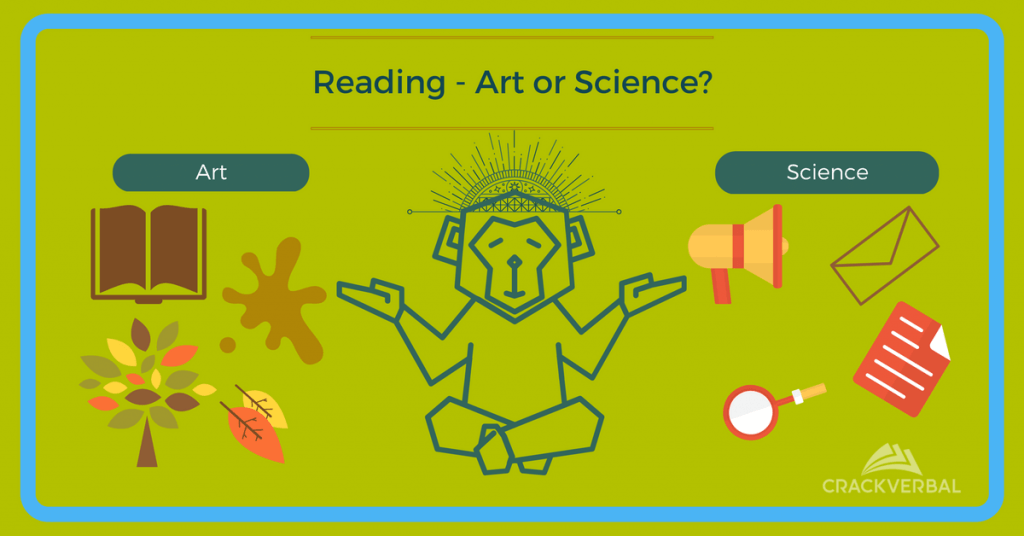 Did you read that? Really?? You must be a GMAT aspirant! 🙂 If you have found your way to this blog, you are probably struggling with an issue that is common to most GMAT aspirants – Making sense of dense RC passages on obscure topics, reading words you have never heard before! We hear you! The problem is, we are usually not accustomed to the level of reading that the GMAT requires of us. So, how much RC is there in the GMAT anyway? The number of RC passages vary, but the number of questions would be in the range of 12-15. RC passages can be characterized as short or long passages. Short passages are 1-2 paragraphs, less than 50 lines long, and usually have 3 questions. Long passages are usually 3-4 paragraphs, more than 50 lines long, and usually have 4 questions.
Did you read that? Really?? You must be a GMAT aspirant! 🙂 If you have found your way to this blog, you are probably struggling with an issue that is common to most GMAT aspirants – Making sense of dense RC passages on obscure topics, reading words you have never heard before! We hear you! The problem is, we are usually not accustomed to the level of reading that the GMAT requires of us. So, how much RC is there in the GMAT anyway? The number of RC passages vary, but the number of questions would be in the range of 12-15. RC passages can be characterized as short or long passages. Short passages are 1-2 paragraphs, less than 50 lines long, and usually have 3 questions. Long passages are usually 3-4 paragraphs, more than 50 lines long, and usually have 4 questions. 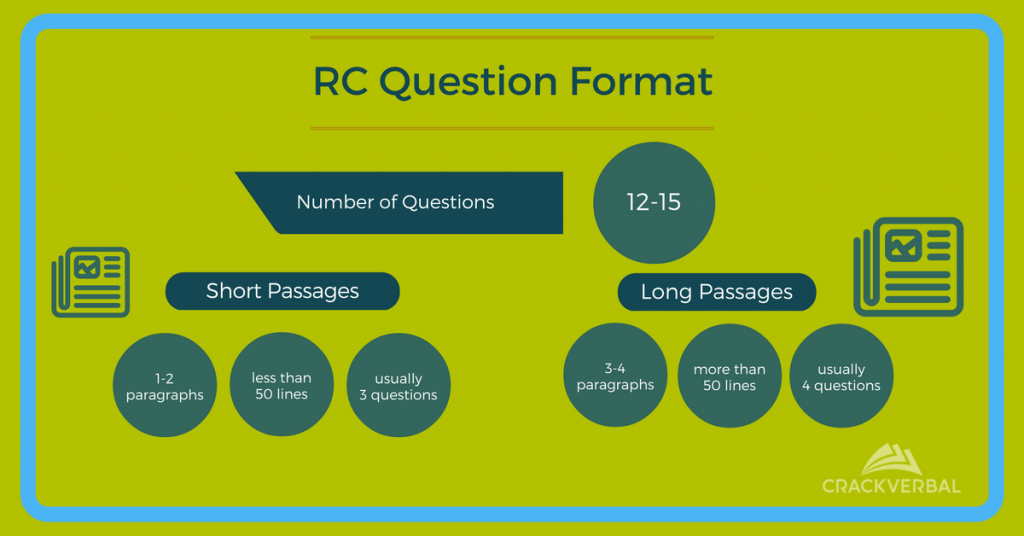 In this blog, we will show you how to score well on GMAT Reading Comprehension, using a bunch of powerful techniques, that will work, regardless of how much reading you have done in your life or how much you used to score on your English exams at school! Here’s a peek into what you will get in this blog – 1. A quick note on active and passive reading, to get you into the right frame of mind to tackle RC questions 2. A step-by-step approach to answering RC questions 3. The types of RC questions you will encounter 4. Practice exercises
In this blog, we will show you how to score well on GMAT Reading Comprehension, using a bunch of powerful techniques, that will work, regardless of how much reading you have done in your life or how much you used to score on your English exams at school! Here’s a peek into what you will get in this blog – 1. A quick note on active and passive reading, to get you into the right frame of mind to tackle RC questions 2. A step-by-step approach to answering RC questions 3. The types of RC questions you will encounter 4. Practice exercises
Active Vs Passive Reading
Imagine yourself in front of the TV. You’re watching the news and simultaneously flipping through a magazine..You’re bored! You chance upon a lifestyle article ( think ‘How to exercise right’ or ‘How to stay healthy in a scorching summer’), and you begin reading. How do you think you would read? Would you delve deep into the subject and try to absorb every detail? Would you try and correlate three things from the text and try to apply it to your current life? Would every fibre of your concentration be focused on that article? Probably not. What you would probably do is Passive Reading. A passive reader – 1. Reads quickly 2. Has a short attention span 3. Will just skim through difficult points, or stop reading altogether. 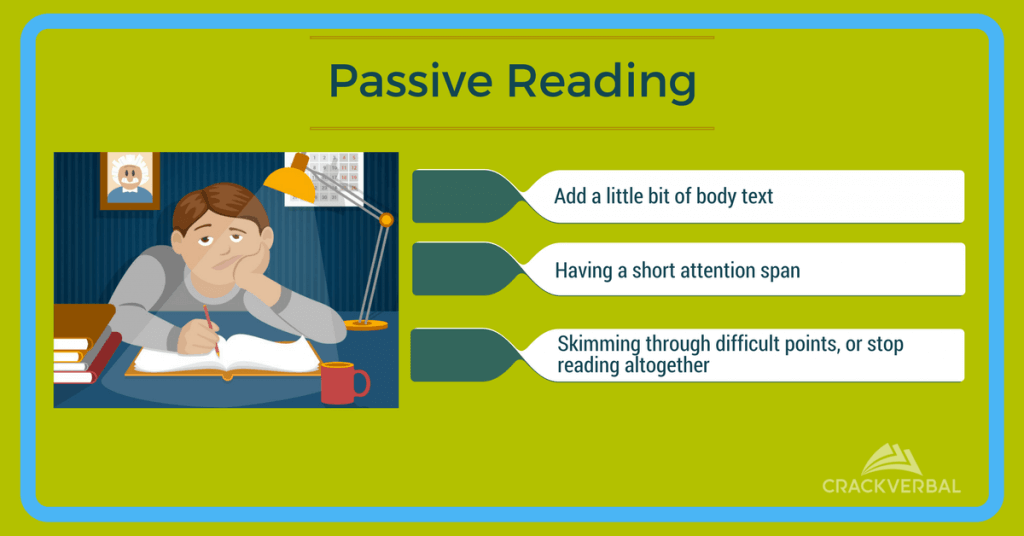 On the other hand, imagine yourself on a cold December Sunday morning, snuggling in your couch while it is raining outside. You have a novel by your favourite author in one hand and a coffee mug in the other. In this situation, how would you read? Would you relate to the characters in the book and imagine the different scenes that you are reading? Would you lose yourself in the book to such a degree that you are not aware of time passing by? Did we hearing you saying yes? Well, this is Active Reading! An active reader – 1. Reads with purpose 2. Asks questions to uncover the purpose and meaning of the text 3. Notes down the main points ( either mentally or down on paper)
On the other hand, imagine yourself on a cold December Sunday morning, snuggling in your couch while it is raining outside. You have a novel by your favourite author in one hand and a coffee mug in the other. In this situation, how would you read? Would you relate to the characters in the book and imagine the different scenes that you are reading? Would you lose yourself in the book to such a degree that you are not aware of time passing by? Did we hearing you saying yes? Well, this is Active Reading! An active reader – 1. Reads with purpose 2. Asks questions to uncover the purpose and meaning of the text 3. Notes down the main points ( either mentally or down on paper) 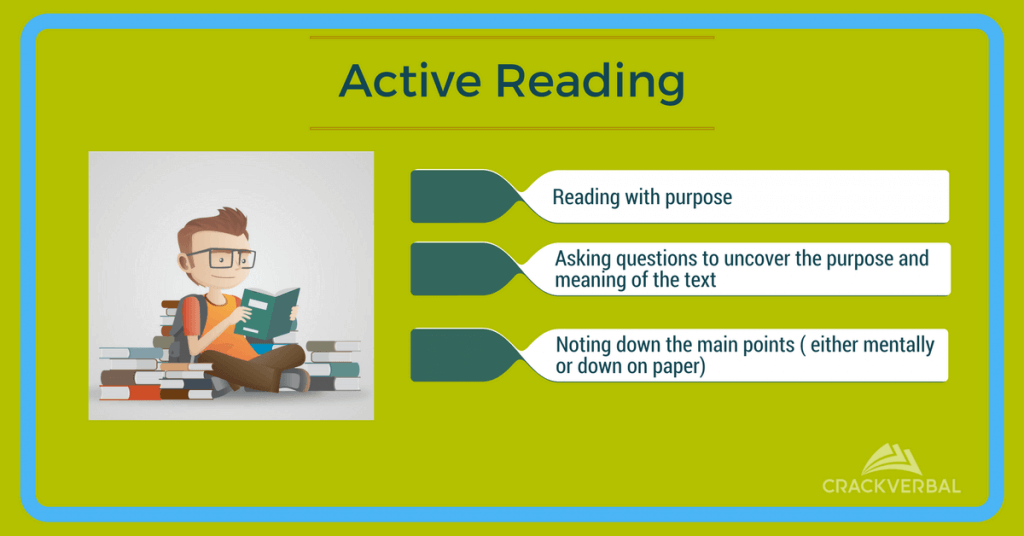 As you may have guessed, Passive Reading isn’t much use on the GMAT..Active Reading is the way to go!
As you may have guessed, Passive Reading isn’t much use on the GMAT..Active Reading is the way to go!
A Step-by-Step Approach to GMAT Reading Comprehension
There’s a lot of advice out there about HOW to solve an RC question. Should you skim through the passage? Should you speed-read? Or should you read it carefully? Should you look for keywords? Should you read a few questions before you read the passage for the first time? There’s way too much advice out there, and it can get overwhelming! Let’s help you keep it simple. Hit the erase button on all the contradictory advice you have heard on the subject, and listen carefully.
1. Skim through the passage once
(a) Read the passage once. Do not try to speed-read, and do not read too slowly. (b) As you are reading, remember this mantra – R-O-S-I ( Read Opinion; Skip Information). 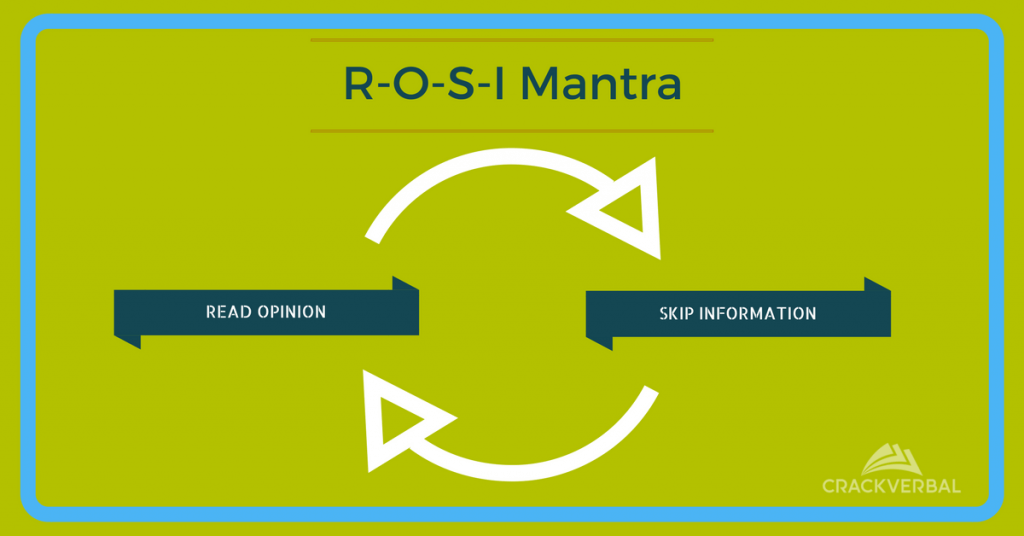 This means that you do not need to remember data points. The data is provided only to support an opinion. The opinion/inference of the author is what you need to focus on. Narrowing your focus thus will reduce the mental bandwidth you need to use, and will also significantly reduce the time you need to read the passage. (c) While you are reading, ensure that you understand – • The first few lines of the passage and the last sentence of the passage – This is because the first few lines of the passage supply the main idea of the passage. Even if you take a day to read the entire passage over and over again, you’ll find that main idea is in the first few lines 🙂 • The first and last sentence of each paragraph – Do this exercise. Pick an RC passage, pick the second paragraph, and remove all sentences except the first and the last one. You will see that MOST of the message of the paragraph is still retained! Even if you haven’t quite grasped a sentence in the middle of the paragraph on your initial reading of the passage, don’t fret about it. Just make sure you understand the first and the last sentence. • Pay attention to keywords that indicate a shift of direction – There are certain ‘directional’ words, such as moreover, however, but, rather, etc, that indicate the flow of meaning between different sentences and paragraphs. As you read, make a mental note of these words and the changes they indicate.
This means that you do not need to remember data points. The data is provided only to support an opinion. The opinion/inference of the author is what you need to focus on. Narrowing your focus thus will reduce the mental bandwidth you need to use, and will also significantly reduce the time you need to read the passage. (c) While you are reading, ensure that you understand – • The first few lines of the passage and the last sentence of the passage – This is because the first few lines of the passage supply the main idea of the passage. Even if you take a day to read the entire passage over and over again, you’ll find that main idea is in the first few lines 🙂 • The first and last sentence of each paragraph – Do this exercise. Pick an RC passage, pick the second paragraph, and remove all sentences except the first and the last one. You will see that MOST of the message of the paragraph is still retained! Even if you haven’t quite grasped a sentence in the middle of the paragraph on your initial reading of the passage, don’t fret about it. Just make sure you understand the first and the last sentence. • Pay attention to keywords that indicate a shift of direction – There are certain ‘directional’ words, such as moreover, however, but, rather, etc, that indicate the flow of meaning between different sentences and paragraphs. As you read, make a mental note of these words and the changes they indicate. 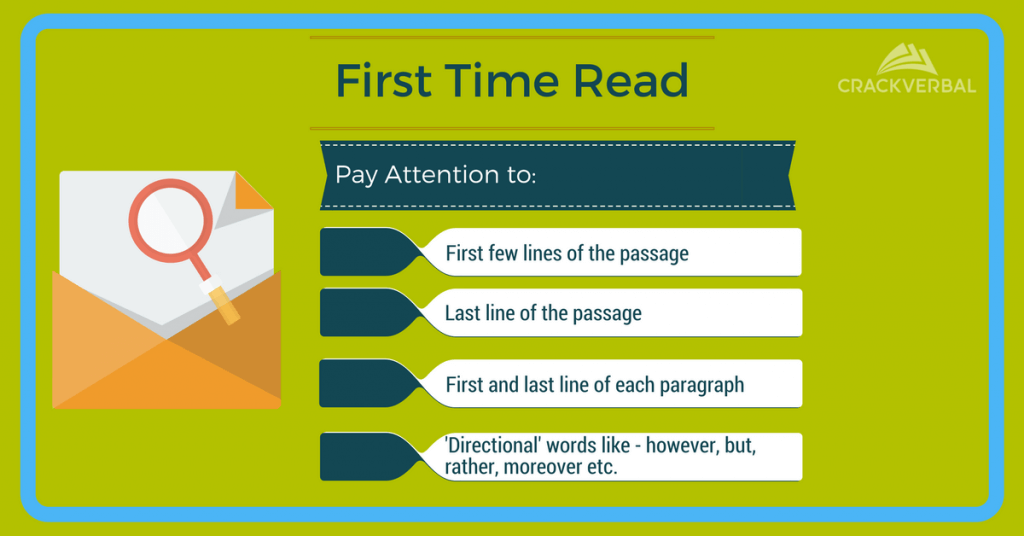
2.Make an Reading Comprehension map as you skim
The single most effective technique on the Reading Comprehension section is note-taking..Or what we call RC maps. We see many students resist the idea of taking notes. And we get it. On the face of it, making a map might look like a waste of very precious time. You may think that you could just make a mental note of it. But here’s why it is important – Remember, you’re not tackling the RC question when you’re feeling your best and brightest. You have already used up a lot of mental energy on previous sections of the test. You need to conserve your energy until the end of the test. Do you really want to coax your brain into memorising what each passage contains? Or do you want to use it more effectively, to actually solve questions? On the RC, use your brain as a processing unit, not a storage unit! Trust us on this..mapping will help you even if you otherwise have a knack for reading, even if you otherwise have a fantastic memory that can remember all sorts of irrelevant details. The very fact that you are tackling the RC section under stress changes the rules of the game, and makes mapping essential! 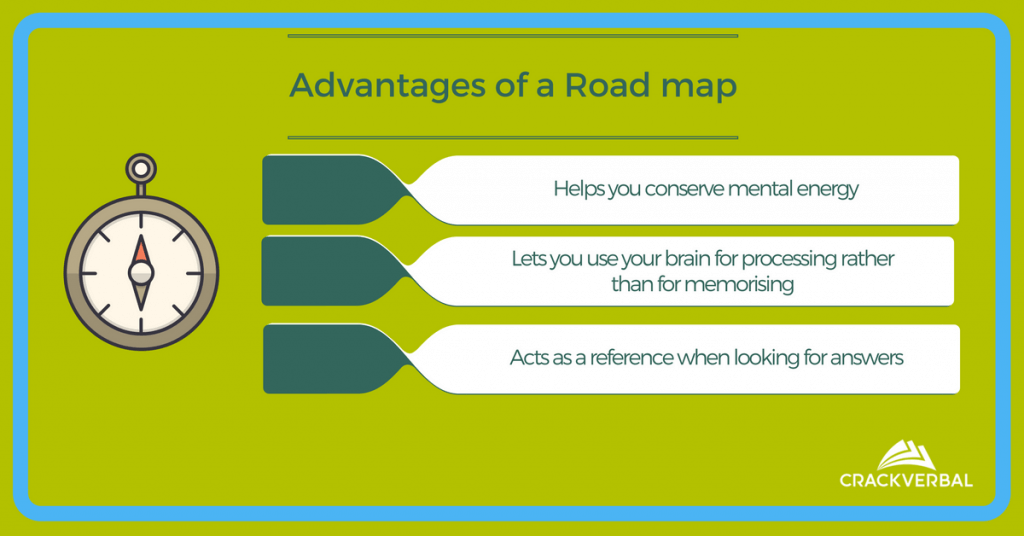 How should your RC Map look? Here are the two things you need to remember as you frame your RC map. (a) Your map should be brief: Your RC map should contain only a few words ( or a few diagrams, if you’re a visual learner) of summing up for each passage. Remember..your map is only a way for YOU to answer quicker. It is not supposed to be a reference for anybody else. So write just enough so that, a few minutes later, you will be able to track down answers using the map. You want to use shorthand or your own secret code or squiggly figures? Go ahead! 🙂 (b) Your map should not contain data: Every sentence in a GMAT passage is either one where the author expresses and opinion or one where the author presents data. When you read a passage for the first time it is important to understand the opinions of the author and the general direction of the passage, but not the actual data. If your question demands factual knowledge, you can always do a quick re-read of the relevant section.
How should your RC Map look? Here are the two things you need to remember as you frame your RC map. (a) Your map should be brief: Your RC map should contain only a few words ( or a few diagrams, if you’re a visual learner) of summing up for each passage. Remember..your map is only a way for YOU to answer quicker. It is not supposed to be a reference for anybody else. So write just enough so that, a few minutes later, you will be able to track down answers using the map. You want to use shorthand or your own secret code or squiggly figures? Go ahead! 🙂 (b) Your map should not contain data: Every sentence in a GMAT passage is either one where the author expresses and opinion or one where the author presents data. When you read a passage for the first time it is important to understand the opinions of the author and the general direction of the passage, but not the actual data. If your question demands factual knowledge, you can always do a quick re-read of the relevant section. 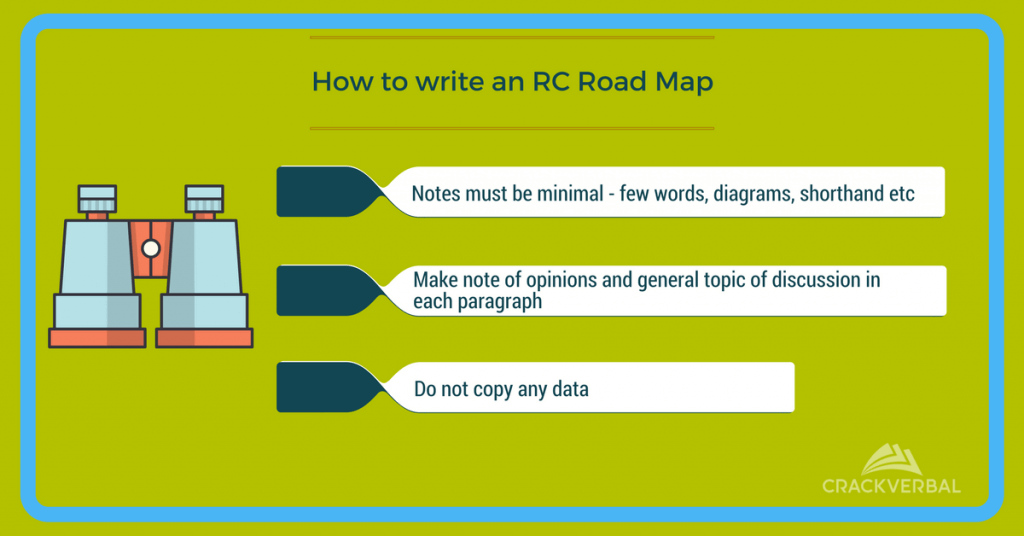 For this reason, do not bother clogging your mind or your RC map with data!
For this reason, do not bother clogging your mind or your RC map with data!
3. Answer the questions!
Now that you have a basic understanding of the passage, start solving the questions. Read the question slowly and carefully. Once you have understood what the question is asking you, quickly glance through the map to understand where you need to go looking for the answer. Let’s say that the map indicates that the answer will be found in paragraph 3. The next thing you need to do is scan through paragraph 3. Scanning is nothing but going through large sections of text rapidly with the intent of zeroing in on a sentence or a set of sentences. As soon as you have arrived at a sentence which looks like it may contain the answer to your question, slow down, read carefully and understand what this section of the passage is conveying. Now read through ALL the answer options. Use the process of elimination to filter out the incorrect options and narrow down to the answer. Unlike the Sentence Correction Section, where you can employ techniques such as Vertical Scanning to quickly eliminate a couple of answer choices, you have to read EACH option carefully on the RC section, to ensure that you choose the most optimal answer! 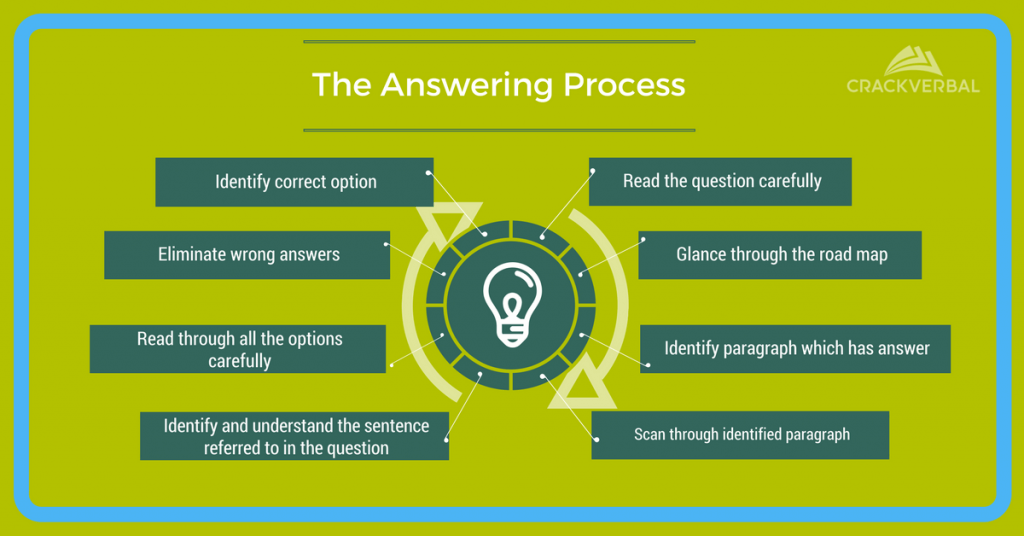 And there it is! You have just solved an RC question 🙂 Remember..Not all RC questions are created equal. Some of them may require a little more effort and time as compared to others. Read the next section for a breakdown of the common types of RC questions that appear on the GMAT!
And there it is! You have just solved an RC question 🙂 Remember..Not all RC questions are created equal. Some of them may require a little more effort and time as compared to others. Read the next section for a breakdown of the common types of RC questions that appear on the GMAT!
QUESTION TYPES on the Reading Comprehension
1. Big Picture Questions/Main Idea questions:
Big picture questions or main idea questions ask you to identify the central theme of a passage. The below questions are the most commonly asked questions on this theme – Which of the following most accurately states the main idea of the passage? The primary purpose of the passage is to The passage is primarily concerned with which of the following? The author of this passage is primarily concerned with The main point made by the passage is that How do you tackle this question type? This is the simplest type of question to answer, because you might not even need to refer to the passage again. The main idea is usually in the first few sentences of the passage, and you may even have down on your map. However, if you are in doubt about whether you got it down correctly, by all means go back and quickly refer the first paragraph and the last couple of sentences of the last paragraph of the passage. 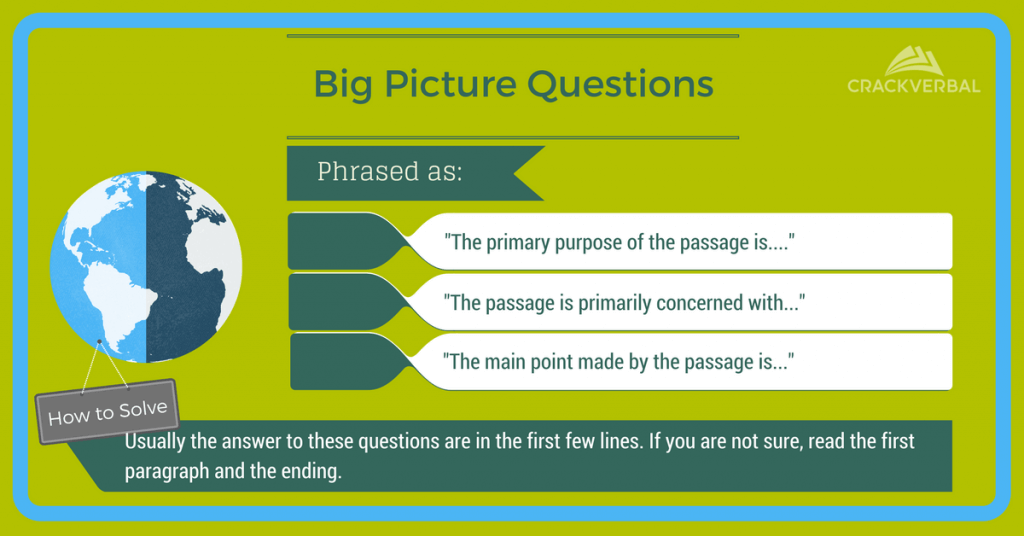
2. Supporting Idea Questions
Supporting idea questions are easy to recognize. They often start with “according to the passage” or “the passage states that”. These questions test your ability to find a specific piece of information contained in the passage. The below questions are common among this type – According to the passage, a questionable assumption about x is that The passage states that ‘a’ occurs because According to the passage, which of the following is true of ‘a’ The passage mentions each of the following EXCEPT According to the passage, if ‘a’ occurs then How do you tackle this question type? These questions are not as easy to answer as main idea questions because you will have to recollect, or re-read a specific portion of text. Start by looking at the map to zero down on which paragraph is the relevant one. Now quickly scan over this paragraph and use the POE technique on the answer options, to arrive at the answer. 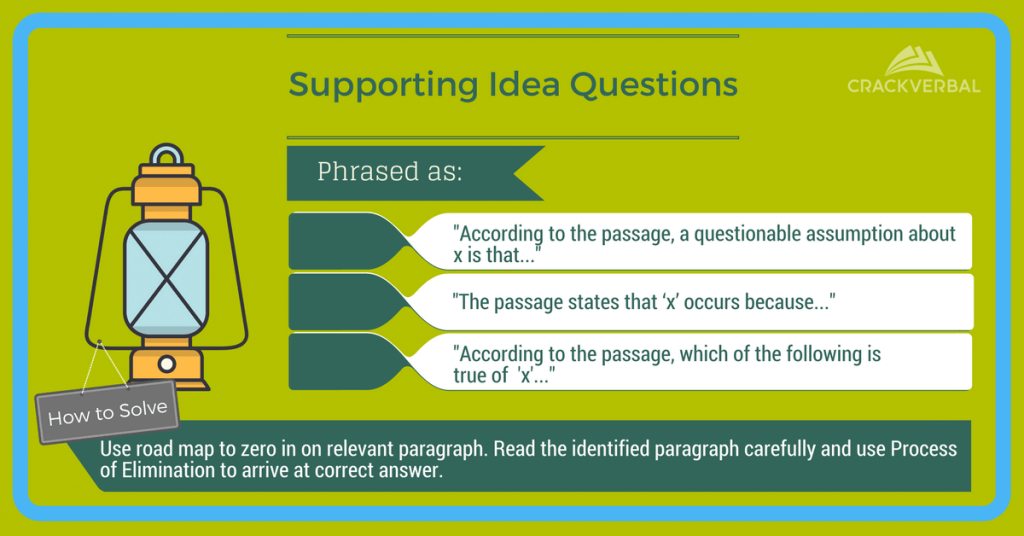
3. Inference/Implied Questions
These questions are very similar to Supporting Idea questions. But they ask you to go a little further and think about what the author implied in a particular set of lines, rather than just what he/she said. Remember, you do not have to stretch your imagination to answer this one- you still have to stay very close to the truth. Just look for the implicit, unwritten message in what the author said. The passage implies that which of the following was true of x It can be inferred from the passage that The passage suggests which of the following about x The author implies that x occurred because The author implies that all of the following statements about x are true EXCEPT How do you tackle this question type? The answer to this question is usually a fairly obvious logical consequence of some sentence in the passage. First, look at the map to zero in on the paragraph you need to read. Next, look at the answer options and use POE. You may have to switch back and forth between the answer options and the paragraph a few times. 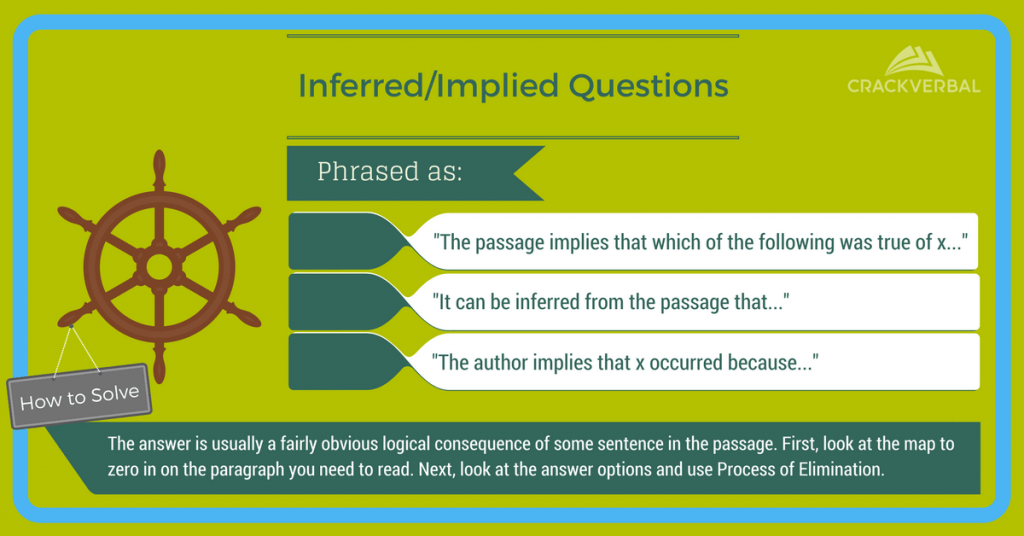
4. Structural questions
Structural questions test you on your awareness of the logical structure of the passage. Some common questions in this type are – The main function of the second paragraph of this passage is to The author uses the adjective ‘a’ in line ‘b’ to express that Which of the following best describes the relation of the third paragraph to the passage as a whole? How do you tackle this question type? This is one of the question types where your map will come to your aid. Even just chalking down the map would have given you an idea of the flow of the passage, even if you have not written down anything in specific about the structure. However, this question could occasionally require a re-read of a section of the passage, with particular attention on words that indicate a shift in direction. 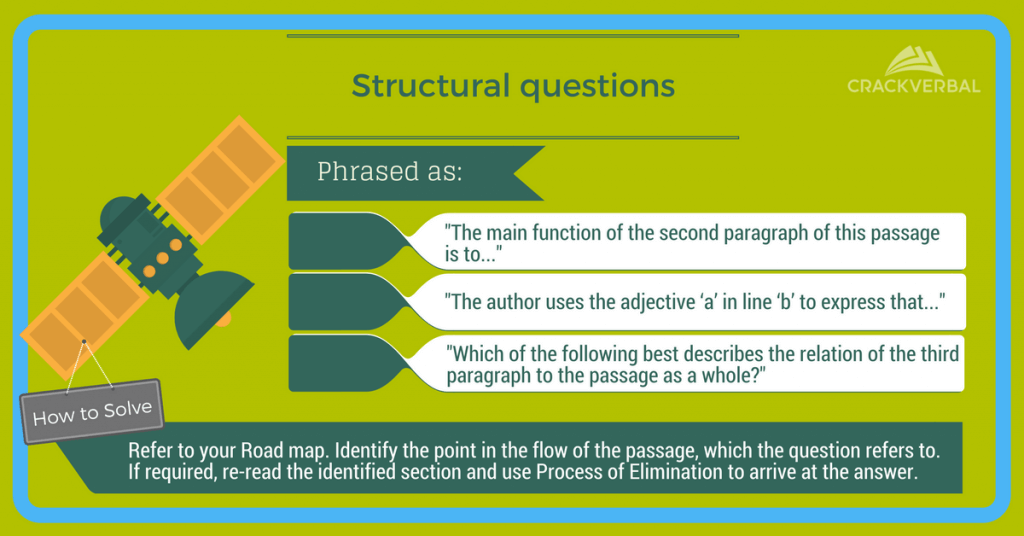
5. Extrapolation Questions
Extrapolation questions require you to go one step further and extrapolate the given information to hypothetical situations. These questions are likely to be in the below form – The author of the passage would be most likely to agree with which of the following? Which of the following statements would provide the most logical continuation of the final paragraph? [an idea or action described in the passage] is most similar to which of the following? How do you tackle this question type? These questions will need some thinking through, and could take a little longer to answer. Amongst these question options given above, those that reference a particular section ( the 2nd and 3rd options ) will probably require lesser effort to answer.
The first type will require you to understand everything the author has opined, before you can take a guess at what else the author could say. 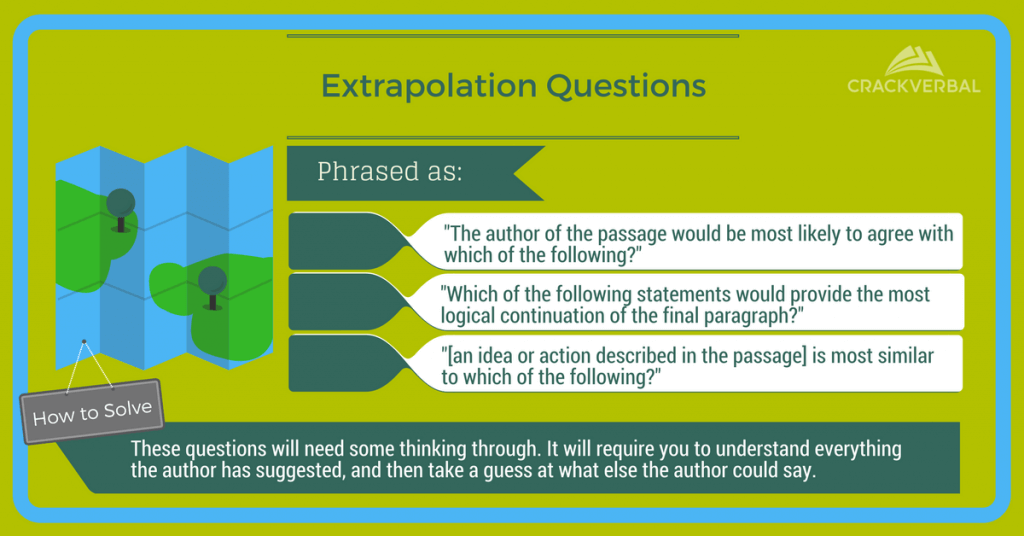
Illustrative Passage
Let us now solve a sample GMAT RC passage. The human species came into being at the time of the greatest biological diversity in the history of the Earth. Today, as human populations expand and alter the natural environment, they are reducing biological diversity to its lowest level since the end of the Mesozoic era, 65 million years ago. The ultimate consequences of this biological collision are beyond calculation, but they are certain to be harmful. That, in essence, is the biodiversity crisis. The history of global diversity can be summarized as follows: after the initial flowering of multicellular animals, there was a swift rise in the number of species in early Paleozoic times (between 600 and 430 million years ago), then plateau like stagnation for the remaining 200 million years of the Paleozoic era, and finally a slow but steady climb through the Mesozoic and Cenozoic eras to diversity’s all-time high. This history suggests that biological diversity was hard won and a long time in coming. Furthermore, this pattern of increase was set back by five massive extinction episodes. The most recent of these, during the Cretaceous period, is by far the most famous, because it ended the age of the dinosaurs, conferred hegemony on the mammals, and ultimately made possible the ascendancy of the human species. But the cretaceous crisis was minor compared with the Permian extinctions 240 million years ago, during which between 77 and 96 percent of marine animal species perished. It took 5 million years, well into Mesozoic times, for species diversity to begin a significant recovery. Within the past 10,000 years biological diversity has entered a wholly new era. Human activity has had a devastating effect on species diversity, and the rate of human-induced extinctions is accelerating. Half of the bird species of Polynesia have been eliminated through hunting and the destruction of native forests. Hundreds of fish species endemic to Lake Victoria are now threatened with extinction following the careless introduction of one species of fish, the Nile perch. The list of such biogeographic disasters is extensive. Because every species is unique and irreplaceable, the loss of biodiversity is the most profound process of environmental change. Its consequences are also the least predictable because the value of Earth’s biota (the fauna and flora collectively) remains largely unstudied and unappreciated; unlike material and cultural wealth, which we understand because they are the substance of our everyday lives, biological wealth is usually taken for granted. This is a serious strategic error, one that will be increasingly regretted as time passes. The biota is not only part of a country’s heritage, the product of millions of years of evolution centered on that place; it is also a potential source for immense untapped material wealth in the form of food, medicine, and other commercially important substance.
(I) Stop here. Read the above passage.
Done? On your initial reading of the passage, we hope you focused on the highlighted sentences as below. This passage has a LOT of data about various eras. All of it is unnecessary information at this point. The important bits, that is, the opinions, are highlighted. The human species came into being at the time of the greatest biological diversity in the history of the Earth. Today, as human populations expand and alter the natural environment, they are reducing biological diversity to its lowest level since the end of the Mesozoic era, 65 million years ago. The ultimate consequences of this biological collision are beyond calculation, but they are certain to be harmful. That, in essence, is the biodiversity crisis. The history of global diversity can be summarized as follows: after the initial flowering of multicellular animals, there was a swift rise in the number of species in early Paleozoic times (between 600 and 430 million years ago), then plateau like stagnation for the remaining 200 million years of the Paleozoic era, and finally a slow but steady climb through the Mesozoic and Cenozoic eras to diversity’s all-time high. This history suggests that biological diversity was hard won and a long time in coming. Furthermore, this pattern of increase was set back by five massive extinction episodes. The most recent of these, during the Cretaceous period, is by far the most famous, because it ended the age of the dinosaurs, conferred hegemony on the mammals, and ultimately made possible the ascendancy of the human species. But the cretaceous crisis was minor compared with the Permian extinctions 240 million years ago, during which between 77 and 96 percent of marine animal species perished. It took 5 million years, well into Mesozoic times, for species diversity to begin a significant recovery. Within the past 10,000 years biological diversity has entered a wholly new era. Human activity has had a devastating effect on species diversity, and the rate of human-induced extinctions is accelerating. Half of the bird species of Polynesia have been eliminated through hunting and the destruction of native forests. Hundreds of fish species endemic to Lake Victoria are now threatened with extinction following the careless introduction of one species of fish, the Nile perch. The list of such biogeographic disasters is extensive. Because every species is unique and irreplaceable, the loss of biodiversity is the most profound process of environmental change. Its consequences are also the least predictable because the value of Earth’s biota (the fauna and flora collectively) remains largely unstudied and unappreciated; unlike material and cultural wealth, which we understand because they are the substance of our everyday lives, biological wealth is usually taken for granted. This is a serious strategic error, one that will be increasingly regretted as time passes. The biota is not only part of a country’s heritage, the product of millions of years of evolution centered on that place; it is also a potential source for immense untapped material wealth in the form of food, medicine, and other commercially important substance.
2. Make an Reading Comprehension Map.
So this is what our Map looks like – Paragraph 1: Introducing the biodiversity crisis -> caused by human populations. Paragraph 2: Biological diversity was hard won. 5 extinction episodes. Paragraph 3: Effect of human activity on biodiversity – specific examples. Paragraph 4: Ignoring this problem is an error because- part of heritage, source of potential wealth. Let us examine each of the following questions in detail –
1. Which one of the following best expresses the main idea of the passage?
(A) The reduction in biodiversity is an irreversible process that represents a setback both for science and for society as a whole. (B) The material and cultural wealth of a nation are insignificant when compared with the country’s biological wealth. (C) The enormous diversity of life on Earth could not have come about without periodic extinctions that have conferred preeminence on one species at the expense of another. (D) The human species is in the process of initiating a massive extinction episode that may make past episodes look minor by comparison. (E) The current decline in species diversity is human-induced tragedy of incalculable proportions that has potentially grave consequences for the human species. Solution: (A) The passage does not indicate that reduction in biodiversity is irreversible; just that recovery is slow. Also, the main idea of the passage is about the role of human populations in this process. (B) This is not indicated anywhere in the passage. (C) Not true. In fact, the passage says that these extinctions slowed down the increase in diversity. (D) Humans may be causing this tragedy by their deeds, but they are not in the process of ‘Initiating’ a massive extinction episode. (E) This is the correct answer. From the map, this is indeed the main idea.
2. Which one of the following situations is most analogous to the history of global diversity summarized in lines 10-18 of the passage?
(A) The number of fish in a lake declines abruptly as a result of water pollution, then makes a slow comeback after cleanup efforts and the passage of ordinances against dumping. (B) The concentration of chlorine in the water supply of large city fluctuates widely before stabilizing at a constant and safe level. (C) An old-fashioned article of clothing goes in and out of style periodically as a result of features in fashion magazines and the popularity of certain period films. (D) After valuable mineral deposits are discovered, the population of a geographic region booms then levels off and begins to decrease at a slow and steady pace. (E) The variety of styles stocked by a shoe store increases rapidly after the store opens, holds constant for many months, and then gradually creeps upward. Solution: The passage talks of a steep increase, then stagnation, then a slow climb. Let us look for a parallel analogy. (A) This option talks of a decline and comeback. Hence incorrect. (B) This talks of a fluctuation and then stabilization. Hence incorrect. (C) This is completely irrelevant as an analogy. (D) This is incorrect because of the decrease after the plateau – we are looking for an increase after the plateau. (E) This is the correct answer. 3. The author suggests which one of the following about the Cretaceous crisis? (A) It was the second most devastating extinction episode in history. (B) It was the most devastating extinction episode up until that time. (C) It was less devastating to species diversity than is the current biodiversity crisis. (D) The rate of extinction among marine animal species as a result of the crisis did not approach 77 percent. (E) The dinosaurs comprised the great majority of species that perished during the crisis. Solution: (A) This is a trap answer. Though the passage says that the Cretaceous crisis was minor compared to the Permian extinctions, it does not say that the Cretaceous crisis was the second most devastating extinction. (B) No. In fact, the passage explicitly says that it was NOT the most devastating. (C) Though the passage does say that current crisis is cause for concern, there is no information to indicate a comparison between the current crisis and the Cretaceous crisis. (D) This is the correct answer. Since the Cretaceous crisis was minor compared to the Permian extinction, which had a 77% -96% rate of extinction, it can be inferred that the Cretaceous crisis did not have this high rate. (E) There is nothing to suggest that dinosaurs formed the majority of species that perished. 4. The author mentions the Nile perch in order to provide an example of (A) a species that has become extinct through human activity (B) the typical lack of foresight that has led to biogeographic disaster (C) a marine animal species that survived the Permian extinctions (D) a species that is a potential source of material wealth (E) the kind of action that is necessary to reverse the decline in species diversity Solution: (A) The Nile Perch has not become extinct. It is the species that endangered many others. (B) This is the correct answer. (C) There is nothing to connect the Nile Perch to Permian extinctions. (D) This is not suggested anywhere. (E) No – the Nile Perch example is used to explain how the decline is being caused – not what needs to be done to reverse the decline.
5. All of the following are explicitly mentioned in the passage as contributing to the extinction of species EXCEPT
(A) hunting (B) pollution (C) deforestation (D) the growth of human populations (E) human-engineered changes in the environment Solution: (A) Hunting is mentioned as a reason in the third paragraph. (B) This is the correct answer. Pollution is not mentioned anywhere in the passage. (C) Destruction of native forests is mentioned in the third paragraph. (D) Growth of human populations – This is suggested not in the third paragraph, but in the very first couple of sentences. (E) This is suggested – The Nile Perch is an example.
6. The passage suggests which one of the following about material and cultural wealth?
(A) Because we can readily assess the value of material and cultural wealth, we tend not to take them for granted. (B) Just as the biota is a source of potential material wealth, it is an untapped source of cultural wealth as well. (C) Some degree of material and cultural wealth may have to be sacrificed if we are to protect our biological heritage. (D) Material and cultural wealth are of less value than biological wealth because they have evolved over a shorter period of time. (E) Material wealth and biological wealth are interdependent in a way that material wealth and cultural wealth are not. Solution: (A) This is the correct answer. This is suggested by the above lines. (B) This is not indicated in the passage. (C) This is not at all indicated. (D) This comparison is not made. (E) Though the passage indicates that biological wealth can increase material wealth ( in the last sentence), there is no comparison made between cultural wealth and biological wealth. 7. The author would be most likely to agree with which one of the following statements about the consequences of the biodiversity crisis? (A) The loss of species diversity will have as immediate an impact on the material of nations as on their biological wealth. (B) The crisis will likely end the hegemony of the human race and bring about the ascendancy of another species. (C) The effects of the loss of species diversity will be dire, but we cannot yet tell how dire. (D) It is more fruitful to discuss the consequences of the crisis in terms of the potential loss to humanity than in strictly biological loss to humanity than in strictly biological terms. (E) The consequences of the crisis can be minimized, but the pace of extinctions can not be reversed. Solution: (A) The impact on the material of nations vs the impact on biological wealth – This comparison is not made in the passage. It just says that the biodiversity crisis could have an impact on material wealth as well. (B) This is not suggested at all. (C) This is the correct answer, as indicated by this line – ‘The ultimate consequences of this biological collision are beyond calculation, but they are certain to be harmful.’ (D) We cannot ascertain this. The author does not express a preference for discussing it in one way or the other – he talks about it in biological terms AS WELL as in terms of potential loss to humanity. (E) The author does not say anything indicating that the consequences can be minimized. With a structured approach to reading, mapping and solving questions, you can turn RC from a many-headed monster to your friend on the GMAT! We hope that this post helps you better your performance on GMAT RC. Now that you’ve cracked the RC section of the GMAT, would you like to learn powerful techniques to help you on other sections on the GMAT as well?
Pro Tip: Think you are ready for an interactive video lesson? Try out our free GMAT Online Trial course.
